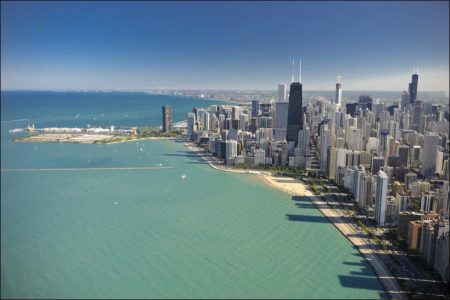The Loop, the crowded rectangle between Wabash Avenue and Lake, Wells, and Van Buren Streets, is bound round with a steel band of elevated tracks, upon which converge trains from all parts of Chicago. The commercial center of the city since the beginning, it received its name in 1897 when the elevated lines were linked and routed to “loop” the district. At the present time the term is used loosely to designate the bustling commercial section that lies around as well as within the steel frame of tracks.
The cluster of towers at the Loop is the expression of Chicago as Big Town, with all the attributes of Big Town: the roar of traffic, on the street and overhead; sidewalks crowded with restless throngs; great movie palaces, and vast department stores. But in the Loop stands a reminder that its economic roots are in the prairie, its primary source of wealth: crowning the Board of Trade Building, the highest elevation in the city, stands a gigantic statue of Ceres, goddess of grain, whose cornucopia of plenty symbolically pours a golden shower of wheat and corn on the city.
>In the buildings of the Loop can be clearly traced the architectural evolution of Metropolis. Within its bounds stand great masonry buildings, in their day among the tallest in the world; some of the first structures built with steel framework; many buildings plainly revealing the painful struggle of architects to adapt old styles to new structural forms; and many newer buildings of simple modern functional design, unadorned and starkly vertical, with no strivings to disguise them as Greek temples, French chateaux, or Chinese pagodas.
Chicago lies on land easily dug for subways but unsuited for heavy building construction, but, paradoxically, it was the first to build skyscrapers and the last of the large cities to tunnel passenger subways. With bedrock in places more than 100 feet below the soft and marshy surface, engineers had to erect the first large buildings on “floating” foundations; caissons were sunk to bedrock to provide footing for modern towers.
Visits: 74



